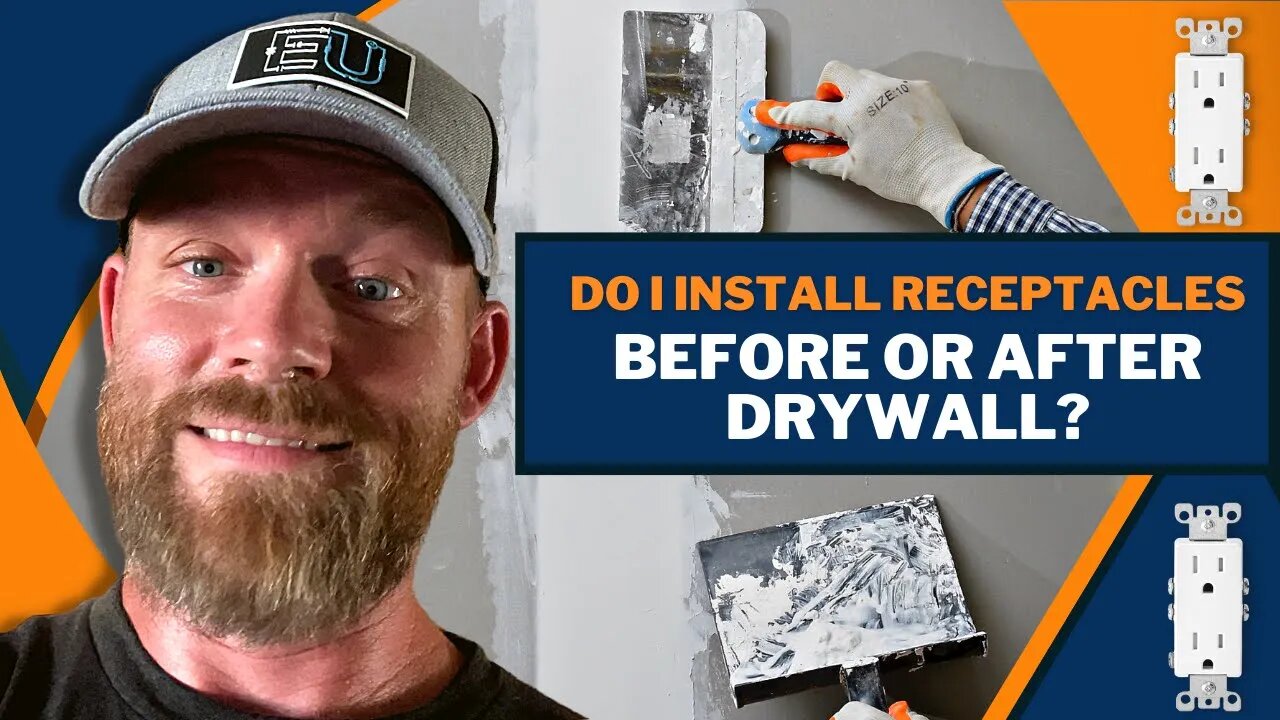Premium Only Content

Installing Receptacles Before or After Drywall?
Have you ever thought about installing your trim devices BEFORE the drywall is hung? A question came in from one of our followers asking this very question. In the latest episode of Electrician U, Dustin discusses this topic and gives some insight on the trim out process.
🤘⚡️MEMBERSHIP⚡️🤘
JOIN ELECTRICIAN U - become a member and get:
FREE Continuing Education every year
FREE Practice Exams
FREE Monthly Video Courses
FREE Weekly Live Instructor-Led Classes
FREE Monthly Educational Newsletter
Premium Members-Only Content
Private Discord Channel
Monthly Members-Only Discord Chats
Sign up here --- https://www.electricianu.com/electrician-u-membership/
🎧🎹MUSIC AND VIDEO:🎹🎧
https://www.facebook.com/descantmv
🎬✍️ART AND ILLUSTRATION:✍️🎬
https://www.daverussoart.com
As electricians, we are usually looking for new and better ways to perform our trades to improve our efficiency and streamline the entire installation process. One of those ways would be to install your devices before the drywall gets installed. Traditionally we install those trim out devices after the drywall goes up. So, what would be possibly gain by installing them prior to the drywall getting hung. Well, it could save a trip(s) out to the jobsite. If you were already onsite, you wouldn’t have to go BACK to the project if you could trim out as soon as you had the project roughed. You could also be looking for a task for one of your crews. At a minimum, it would save the time that you would burn by rolling up all your tools/materials/etc. and then remobilizing just to put the devices in.
However, there are a few issues that would certainly arise by doing things this way. First, most drywallers nowadays use some form of powered tool to cut the device openings in the drywall for our devices. For the most part, gone are the days of those tradesmen (and women) of accurately measuring the devices, marking the drywall, and then taking a sheetrock saw/razor knife to cut the drywall. They now generally roughly hang the drywall on the wall (or hold it up on the studs) and plunge the router into the box through the drywall and make the cuts that way. And if you were to install the devices prior to that process, you would have MANY devices that were damaged. It would probably cost you more TIME and materials by having to replace all the damaged ones. Something else to consider would be the tabs that hold the devices up against the sheetrock to make positive contact. These ears are larger than the box (by design) and would require the drywall installers to cut larger holes than necessary to accommodate them. You would then be forced to use something like a caterpillar to support the device. And while they aren’t awfully expensive, it is an expense, nonetheless.
Another item to consider would be putting the devices in prior to drywall mudding or painting. This also may result in you having to replace an abundance of devices if they crew doing the taping/mudding happen to get a bunch of drywall mud all over your devices (and trust me they will!! That process is not super neat and tidy!). This is especially true if you are using Decora style rocker switches. If any drywall mud gets into the paddle, the switch may not work as it should, even if the devices are wiped off. The same is true for painting. The paint crews will undoubtedly paint several (if not all) of your devices forcing you to replace them. Even if the devices are taped off, someone will inevitably attempt to plug something into a device that is taped off, leaving painters tape IN the slots of the receptacle.
There are device plates on the market that are available to protect against damage of devices from paint/drywall mud. Most of them look like a metal or plastic cover that entirely covers the device. But again, you would be hamstringing the drywallers by not allowing them to use their routers to cut out for your devices. Most times they will just remove those plates and throw them on the floor to get lost or damaged. And with them removed, they will now, more than likely, damage your devices and you would be stuck in the same boat!
While new ways of working efficiently are certainly encouraged, this is one of them that we should probably leave just as we have been doing for years!
Is there a topic you would like to see a video on? Leave a comment in the comments section and let us know! Please continue to follow Dustin and Electrician U as we are constantly adding new content to assist our followers in becoming the best electricians they can be!
-
 0:58
0:58
Electrician U
1 year agoFISH STICKS! Every electrician needs these!
6.01K -
 1:20:04
1:20:04
Tim Pool
4 days agoGame of Money
42.6K10 -
 2:21:11
2:21:11
Nerdrotic
10 hours ago $22.20 earnedDown the Rabbit Hole with Kurt Metzger | Forbidden Frontier #090
93.7K19 -
 2:41:13
2:41:13
vivafrei
15 hours agoEp. 251: Bogus Social Security Payments? DOGE Lawsduit W's! Maddow Defamation! & MORE! Viva & Barnes
226K261 -
 1:19:23
1:19:23
Josh Pate's College Football Show
8 hours ago $3.57 earnedBig Ten Program Rankings | What Is College Football? | Clemson Rage| Stadiums I Haven’t Experienced
57.7K1 -
 LIVE
LIVE
Vigilant News Network
14 hours agoBombshell Study Reveals Where the COVID Vaccine Deaths Are Hiding | Media Blackout
1,813 watching -
 1:17:59
1:17:59
Sarah Westall
9 hours agoDOGE: Crime & Hysteria bringing the Critics & the Fearful - Plus new CDC/Ukraine Crime w/ Dr Fleming
46.6K3 -
 45:39
45:39
Survive History
15 hours ago $8.39 earnedCould You Survive in the Shield Wall at the Battle of Hastings?
58.3K6 -
 1:50:28
1:50:28
TheDozenPodcast
14 hours agoViolence, Abuse, Jail, Reform: Michael Maisey
96.7K4 -
 23:01
23:01
Mrgunsngear
1 day ago $5.62 earnedWolfpack Armory AW15 MK5 AR-15 Review 🇺🇸
83.1K12